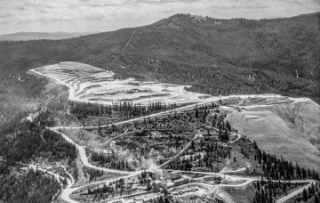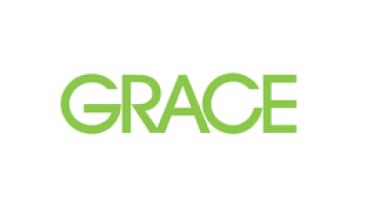
W.R. Grace & Co.
W.R. Grace & Co. established a trust fund to compensate people after facing lawsuits over its asbestos-containing products and contaminated Libby mine. Asbestos litigation forced the company to file for bankruptcy in 2001. Two trusts were formed in 2014 to settle asbestos claims.

W.R. Grace’s Asbestos History
W.R. Grace has a long history of using asbestos in its products. These include cement, plaster, spray fireproofing, and surface products. It expanded as a maker of asbestos products by buying Zonolite Company.
The company also mined vermiculite in Libby, Montana. The Libby mines had high asbestos levels. This caused more disease and deaths among residents.
3x
The amount W.R. Grace’s Monokote spray exceeded OSHA’s asbestos limit in the 1980s.
Source: Tampa Bay Times
Zonolite and W.R. Grace operated an exfoliation plant in Easthampton, MA, from 1963 to 1992. The site was then leased to JPS Acquisition Elastomerics Company through 2000. Grace had to clean contaminated soils at the site. It was from its past use for vermiculite processing. Grace filed for bankruptcy protection in April 2001.
Criminal Charges
In 2005, the U.S. government charged W.R. Grace and its top executives. They had covered up the asbestos contamination’s health effects in Libby. It further argued that executives obstructed government cleanup efforts.
Company records showed executives knew the asbestos in the vermiculite mine was harming miners and residents since the 1970s. The defense argued that the documents showed the company was trying to find hazardous conditions.
A human and environmental tragedy has occurred in Libby. This prosecution seeks to hold Grace and its executives responsible for the misconduct alleged.
The W.R. Grace trial began in February 2009. After 3 months of testimony, the jury acquitted the defendants of all charges. Many Libby residents felt disappointed. They believe the ruling was due to two things. First, the restriction of evidence before 1999. Second, the timing of the mine’s closure in relation to the Clean Air Act.

Get help paying for treatment and other expenses by accessing trust funds, grants and other options.
Access Funds NowW.R. Grace Asbestos Trust
W.R. Grace filed for Chapter 11 bankruptcy in April 2001. It aimed to resolve over 129,000 asbestos-related injury claims. In September 2008, Grace filed a Joint Plan of Reorganization. It outlined a settlement with the involved parties. The plan was amended and approved later. Grace emerged from bankruptcy on February 3, 2014.
The Joint Plan of Reorganization created 2 trusts. They will handle claims for personal injury and property damage due to Grace’s asbestos. The WRG Asbestos PI Trust handles claims for asbestos-related diseases like mesothelioma.
- 2024: In May, Trustees approved an amendment to payment distribution procedures for the WRG Asbestos PT Trust changing the sequencing adjustment factor to 1%.
- 2023: Trustees reduced the payment percentage for injury claims to 31.7% in May. This is still higher than many other asbestos trusts.
- 2021: The trust no longer requires notarized authentication of exposure evidence and will accept the signature of one witness.
- 2019: Trustees raised the payment percentage rate from 26% to 35% in September 2019.
- 2017: The trust changed the statute of limitations, allowing claimants to file for injuries prior to 2001 through February 2018.
- 2014: The trust began accepting personal injury claims on August 25.
The WRG Asbestos Property Damage Trust helps pay to clean up asbestos from Zonolite attic insulation. Security and Exchange Commission filings show Grace had $60.8 million in legacy environmental response costs as of March 31, 2017.
W.R. Grace Lawsuits Involving Asbestos
Some people file W.R. Grace lawsuits to seek damages. They want compensation and punitive damages. Many claims go through the WRG asbestos trusts. It helps pay medical bills and holds the company accountable. Many cases settle before court. But there are some notable jury verdicts against Grace.
- $36.5 Million:In 2022, a Montana jury awarded Ralph Hutt $36.5 million. They agreed that W.R. Grace and its workers’ comp provider failed to ensure safety.
- $18.5 Million: In 2023, Grace and the State of Montana agreed to an $18.5 million settlement. The company will pay the amount plus interest over 10 years.
- $16.25 Million: In 2008, a New York jury awarded $16.25 million to Marvin Penn. He developed mesothelioma after exposure to asbestos products. The jury found Grace 40% liable for Penn’s injuries.
Today, Libby residents’ W.R. Grace lawsuits seek compensation for asbestos-related diseases. They often also name other defendants who did business with W.R. Grace. Some defendants are Grace’s insurers, Burlington Northern Santa Fe and International Paper.
W.R. Grace’s Asbestos Products
Through its acquisitions, W.R. Grace & Co. became a major supplier of paints and plasters. Its other products included surfacers, cement, insulation and fireproofing materials that utilized asbestos. Many of these asbestos-containing products were sold under the Zonolite, Monokote and Perltex brand names.
W.R. Grace’s asbestos-containing products included:
- Mono-Kote Cement
- Mono-Kote Fireproofing
- Zono-Coustic
- Zonolite Acoustical Plaster
- Zonolite Insulating Cement
- Zonolite Econowhite
- Zonolite Fireproofing
- Zonolite High-Temperature Insulating Cement
- Zonolite Plaster
- Zonolite MK-1 & MK-2 Spray Insulation
- Zonolite Spraytex
- Zonolite Super 40 Spray Surfacer
Zonolite insulation was not supposed to contain asbestos. But the contaminated vermiculite from Grace’s Libby mine ended up in the insulation. This exposed many Grace workers and homeowners. They didn’t know to take precautions.
Workers at Risk of Asbestos Exposure
Many workers who handled raw materials for W.R. Grace or used the company’s products experienced occupational asbestos exposure. These individuals are at an increased risk of developing asbestos-related diseases.
Grace employees worked in mines, mills and processing plants. Other employees transported asbestos-contaminated vermiculite and asbestos products for the company. Home improvement professionals who handled finished asbestos products also faced increased exposure risk.
- Carpenters
- Construction workers
- Demolition workers
- HVAC technicians
- Insulators
- Miners
- Mill workers
- Painters
- Plant workers
Mine, mill, and plant workers are at the highest risk of asbestos-related diseases. Insulators and homeowners who used Zonolite insulation were also at high risk of exposure to asbestos.
Some family members of Grace employees had secondhand asbestos exposure. They developed related diseases. Also, many people near the Libby mine or Grace’s plants were exposed to asbestos from pollution. They lived, worked, or went to school there.
First responders and survivors of the 9/11 attack on NYC were exposed to Libby asbestos. Grace’s Zonolite Mono-kote was the brand of spray-on asbestos fireproofing applied to the north tower of the World Trade Center.
W. R. Grace’s Asbestos and Asbestos-Related Diseases
Libby amphibole disease is an umbrella term for chest illnesses related to exposure to Libby amphibole asbestos. Other asbestos-related diseases associated with W.R. Grace’s operations include mesothelioma, asbestosis and pleural abnormalities. In one study, 87% of miners exposed to Libby Amphibole had CT-identified pleural abnormalities. A 2024 study from researchers at the University of Hawaiʻi at Mānoa, Honolulu in Environmental Pollution explains that lung and laryngeal cancers are closely associated with asbestos exposure.
2,900
The approximate number of people diagnosed with asbestos-related diseases in Libby, Montana alone as a result of W.R. Grace’s operations.
Source: American Journal of Industrial Medicine
Mesothelioma is a serious type of cancer with no cure. It develops in the pleura, or lining of organs, and most often affects the lungs. Mesothelioma can also develop in the abdominal cavity or around the heart or testicles.
Asbestos traveled well beyond the Libby mines. Processing facilities were as widespread as Massachusetts, Louisiana and Hawaii. Many former employees of these sites and nearby residents developed asbestos-related diseases.
Libby Asbestos Superfund Site
The Environmental Protection Agency began cleanup around the Libby vermiculite mine in 2000. The Libby Asbestos Superfund site was added to the National Priorities List in 2002. In 2009, the EPA declared a Public Health Emergency. This historic action aimed to help residents access health care.
They started remediation in 2010 and completed it in 2018, except for at the former mine. As of November 2018, the EPA had investigated over 7,600 properties. It removed over one million cubic yards of contaminated soil from over 2,600 of them within the Superfund site. The Libby Asbestos Superfund site was removed from the National Priorities List in August 2024.
EPA, in cooperation with the state of Montana, is conducting the third five-year review of the Libby Asbestos Superfund site in Lincoln County, Montana. This five-year review will be released in 2025.
In August 2024, the EPA removed about 400 acres of Stimson Lumber’s land from the Libby Asbestos Superfund site. More than 50% of the former site is now decontaminated and free from asbestos. The EPA says the authorities must clean the former mine area, the only operable unit.
Recommended Reading


